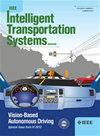基于粒子群优化的通信延迟虚拟耦合列车在线优化方法
IF 5
3区 工程技术
Q1 ENGINEERING, ELECTRICAL & ELECTRONIC
IEEE Intelligent Transportation Systems Magazine
Pub Date : 2023-11-01
DOI:10.1109/mits.2023.3293760
引用次数: 0
摘要
本文章由计算机程序翻译,如有差异,请以英文原文为准。
A Particle Swarm Optimization-Based Online Optimization Approach for Virtual Coupling Trains With Communication Delay
Virtual coupling allows multiple trains to run synchronously in a virtually coupled formation via train-to-train (T2T) wireless communication. The distance between virtual coupling trains can be reduced greatly to improve the line capacity. However, the time delay in T2T communication cannot be avoided, and the delay may fluctuate due to the uncertainties in the train operation, which will negatively impact the virtual coupling trains. In this article, a particle swarm optimization (PSO)-based online optimization approach for virtual coupling that considers the nondeterministic delay in T2T communication is presented. The optimization objectives include energy consumption, ride comfort, operation speed, and the distance between trains. The PSO algorithm is adopted to solve the problem online so that the train can be controlled according to the optimized traction/braking acceleration. The simulation was conducted with data from the existing Beijing subway line, and the results show that the proposed method reduces the impact of nondeterministic delay on virtual coupling significantly. The speed error of the follower train is below 0.3 m/s, and the tracking distance error is below 0.8 m. Moreover, the requirements of real-time control and ride comfort are satisfied.
求助全文
通过发布文献求助,成功后即可免费获取论文全文。
去求助
来源期刊

IEEE Intelligent Transportation Systems Magazine
ENGINEERING, ELECTRICAL & ELECTRONIC-TRANSPORTATION SCIENCE & TECHNOLOGY
CiteScore
8.00
自引率
8.30%
发文量
147
期刊介绍:
The IEEE Intelligent Transportation Systems Magazine (ITSM) publishes peer-reviewed articles that provide innovative research ideas and application results, report significant application case studies, and raise awareness of pressing research and application challenges in all areas of intelligent transportation systems. In contrast to the highly academic publication of the IEEE Transactions on Intelligent Transportation Systems, the ITS Magazine focuses on providing needed information to all members of IEEE ITS society, serving as a dissemination vehicle for ITS Society members and the others to learn the state of the art development and progress on ITS research and applications. High quality tutorials, surveys, successful implementations, technology reviews, lessons learned, policy and societal impacts, and ITS educational issues are published as well. The ITS Magazine also serves as an ideal media communication vehicle between the governing body of ITS society and its membership and promotes ITS community development and growth.
 求助内容:
求助内容: 应助结果提醒方式:
应助结果提醒方式:


